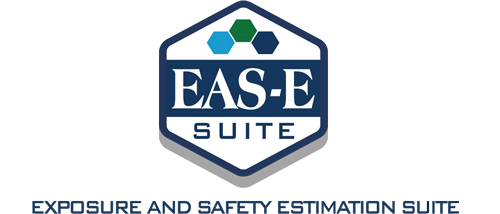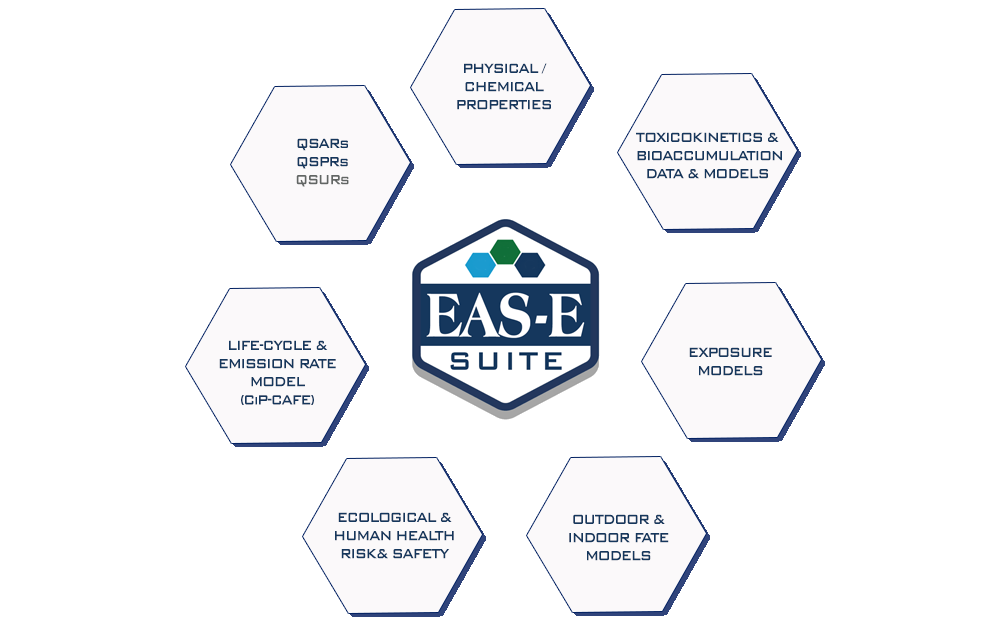The required information for assessing the potential impacts of thousands of organic chemicals on ecological and human health is often quite limited. Models are required to address data gaps and support decision-making. A general lack of time and expertise to parameterize and apply exposure estimation tools may limit their implementation to aid decision-making.
The Exposure And Safety Estimation (EAS-E) Suite platform was developed by ARC Arnot Research and Consulting (ARC) to address some challenges for ecological and human health assessment. EAS-E Suite (pronounced “EASY Suite”) includes chemical information databases, quantitative structure activity relationships (QSARs) for predicting chemical information, and some relevant tools and models to support chemical hazard, exposure, and risk estimation.
EAS-E Suite quantifies the relationships between chemical production volumes, partitioning properties, degradation rates, fate and transport in natural and manufactured environments (i.e., indoors), human and ecological exposures, and the potential for adverse effects at a screening-level. EAS-E Suite contains chemical information required to use many environmental fate and exposure models, as well as bioaccumulation and physiologically based toxicokinetic (PBTK) models. Built in databases provide initial values to apply models coded within the EAS-E Suite platform. For chemicals that are not in the built-in databases users can enter a SMILES notation to obtain predictions from the IFSQSAR models to autoparameterize the various models in EAS-E Suite. The data can also be used to address data gaps in chemical evaluations and for applying other models that are not included in the EAS-E Suite platform.
- Integrates curated databases, validated QSARs, environmental fate, physiologically based toxicokinetics (PBTK), and exposure models for humans and ecological receptors
- The built-in databases for ca. 70,000 discrete organic chemicals include measured and predicted physical-chemical properties commonly required for chemical assessments and parameterizing models, e.g., molar mass, solubility, vapor pressure, partition coefficients (Kow, Kaw, Koa)
- The built-in databases for ca. 70,000 discrete organic chemicals include measured and predicted half-life values commonly required for chemical assessments and parameterizing models, e.g., half-lives in air, water, soil, sediment and biotransformation half-lives in fish and mammals
- The US EPA’s OPERA QSAR models are inlcuded for physical-chemical property and fish biotransformation half-life prediction
- Iterative Fragment Selection (IFS) models & QSARINS models are included for biotransformation half-lives in fish and humans and total elimination half-lives in humans
- The built-in databases and QSARs are used to auto-parameterize the models from a user-entered SMILES notation (or CAS or name), while allowing options for user-preferred inputs of select model input parameters
- Users can choose the entire flow (e.g., from production volume to exposure and safety estimation) or just a particular model (e.g., RAIDAR-ICE for indoor fate and human exposure, or HTTK)
- Can be expanded to include other models, tools and databases and customized to suit end-user preferences and assessment challenges
We are actively seeking stakeholder partnerships to enhance and expand the EAS-E Suite platform
User Feedback
EAS-E Suite is intended to aid the multi-stakeholder community advance chemical safety and sustainability objectives. EAS-E Suite will continue to evolve with incremental refinements to advance and update the platform. We welcome user comments and suggestions for improving the EAS-E Suite platform. If you have comments or suggestions for the development of EAS-E Suite, please fill out this brief form.
Thank you for your interest in EAS-E Suite.
This site and it’s contents are copyright ARC Arnot Consulting & Research 2020
Limitations of liability and disclaimer of warranty
Users assume the entire risk as to the results and performance of the models and databases. ARC Arnot Research & Consulting Inc. and all associated collaborators are not liable under any circumstances, for any damages whatsoever, arising out of the use, or the inability to use, the models and databases provided, even if advised of the possibility of such damages.


